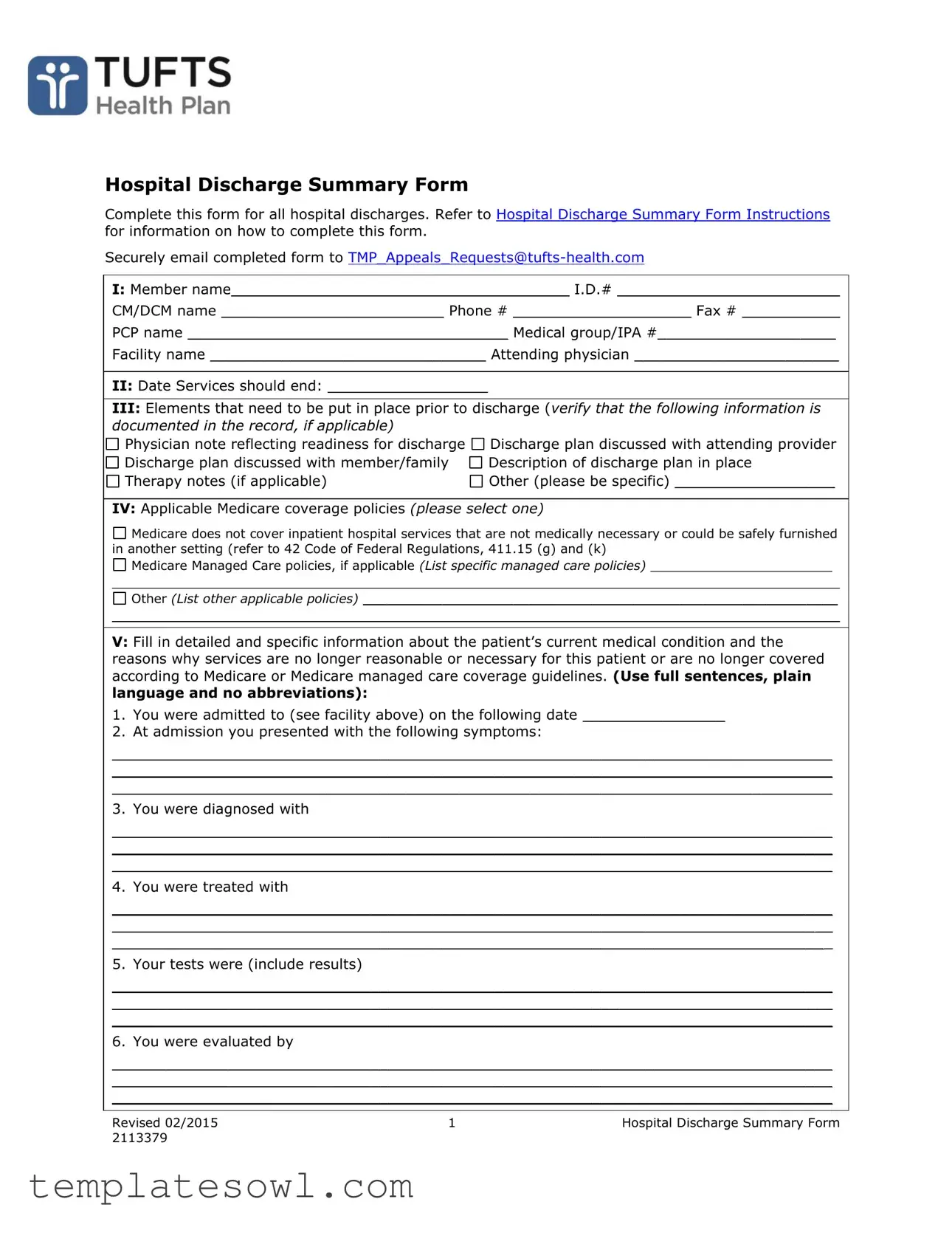Hospital Discharge Summary Form
Complete this form for all hospital discharges. Refer to Hospital Discharge Summary Form Instructions for information on how to complete this form.
Securely email completed form to TMP_Appeals_Requests@tufts-health.com
I:Member name______________________________________ I.D.# _________________________
CM/DCM name _________________________ Phone # ____________________ Fax # ___________
PCP name ____________________________________ Medical group/IPA #____________________
Facility name _______________________________ Attending physician _______________________
II:Date Services should end: __________________
III:Elements that need to be put in place prior to discharge (verify that the following information is documented in the record, if applicable)
Physician note reflecting readiness for discharge |
Discharge plan discussed with attending provider |
Discharge plan discussed with member/family |
Description of discharge plan in place |
Therapy notes (if applicable) |
Other (please be specific) __________________ |
IV: Applicable Medicare coverage policies (please select one)

 Medicare does not cover inpatient hospital services that are not medically necessary or could be safely furnished in another setting (refer to 42 Code of Federal Regulations, 411.15 (g) and (k)
Medicare does not cover inpatient hospital services that are not medically necessary or could be safely furnished in another setting (refer to 42 Code of Federal Regulations, 411.15 (g) and (k)

 Medicare Managed Care policies, if applicable (List specific managed care policies) _______________________
Medicare Managed Care policies, if applicable (List specific managed care policies) _______________________
____________________________________________________________________________________________

 Other (List other applicable policies) ____________________________________________________________
Other (List other applicable policies) ____________________________________________________________
____________________________________________________________________________________________
V:Fill in detailed and specific information about the patient’s current medical condition and the reasons why services are no longer reasonable or necessary for this patient or are no longer covered according to Medicare or Medicare managed care coverage guidelines. (Use full sentences, plain language and no abbreviations):
1.You were admitted to (see facility above) on the following date ________________
2.At admission you presented with the following symptoms:
_________________________________________________________________________________
_________________________________________________________________________________
_________________________________________________________________________________
3. You were diagnosed with
_________________________________________________________________________________
_________________________________________________________________________________
_________________________________________________________________________________
4. You were treated with
_________________________________________________________________________________
_________________________________________________________________________________
_________________________________________________________________________________
5. Your tests were (include results)
_________________________________________________________________________________
_________________________________________________________________________________
_________________________________________________________________________________
6. You were evaluated by
_________________________________________________________________________________
_________________________________________________________________________________
_________________________________________________________________________________
Revised 02/2015 |
1 |
Hospital Discharge Summary Form |
2113379 |
|
|
7. You are now (list current treatment plan and/or state the medical issue is resolved)
_________________________________________________________________________________
_________________________________________________________________________________
_________________________________________________________________________________
8.Your provider feels that your condition has improved and that the care you need now could safely be provided in/at
_________________________________________________________________________________
_________________________________________________________________________________
_________________________________________________________________________________
9. Your discharge plan and follow-up care includes
_________________________________________________________________________________
_________________________________________________________________________________
_________________________________________________________________________________
VI: Printed name of person completing the form __________________________________________
Signature of person completing the form ________________________________________________
Phone # ___________________________________ Fax # _________________________________
Provider Relations
Revised 02/2015 |
2 |
Hospital Discharge Summary Form |



 Medicare does not cover inpatient hospital services that are not medically necessary or could be safely furnished in another setting (refer to 42 Code of Federal Regulations, 411.15 (g) and (k)
Medicare does not cover inpatient hospital services that are not medically necessary or could be safely furnished in another setting (refer to 42 Code of Federal Regulations, 411.15 (g) and (k)
 Medicare Managed Care policies, if applicable
Medicare Managed Care policies, if applicable 
 Other
Other 